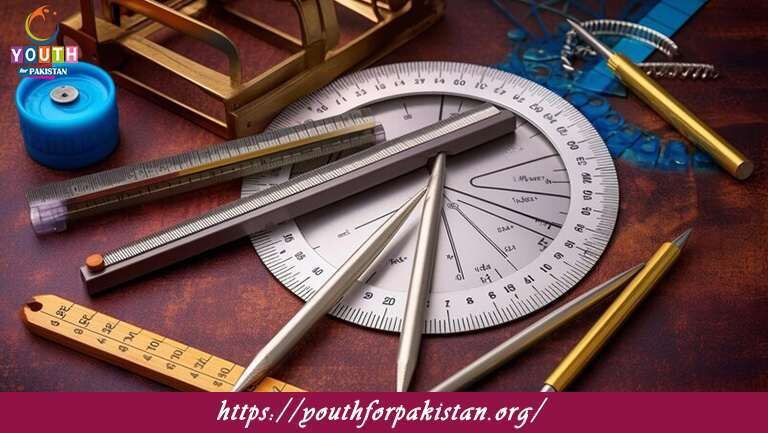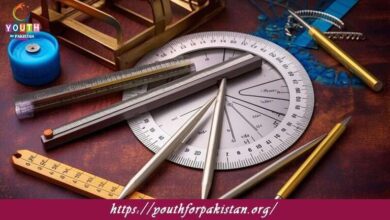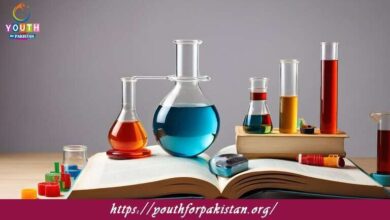9th Class Physics Chapter 1 MCQs with Answers

9th Class Physics Chapter 1 MCQs- Introduction to physical quantities and their measurement lays the foundation for understanding units, dimensions, and just how critical proper measurement is in science Enhance your accuracy using MCQ practice questions on Physical Quantities and Measurement for the exam and strengthen your conceptual clarity.
Major Topics for This Chapter
The same SI unit is very significant for physical quantities like mass and length and for time, also. It becomes very apparent that the proper manner of measurement and unit conversion is the very key to solving problems.
What is the SI unit of length?
a) Meter
b) Kilogram
c) Second
d) Kelvin
Which instrument is used to measure atmospheric pressure?
a) Thermometer
b) Hygrometer
c) Barometer
d) Altimeter
What is the SI unit of time?
a) Hour
b) Minute
c) Second
d) Day
Which physical quantity represents the amount of matter in an object?
a) Volume
b) Density
c) Mass
d) Weight
The speed of light in a vacuum is approximately:
a) 300,000 km/s
b) 30,000 km/s
c) 3,000 km/s
d) 300 km/s
Which instrument is used to measure electric current?
a) Voltmeter
b) Ammeter
c) Ohmmeter
d) Galvanometer
The volume of a cube with sides of length 5 cm is:
a) 15 cm³
b) 25 cm³
c) 100 cm³
d) 125 cm³
What is the SI unit of electric charge?
a) Ampere
b) Coulomb
c) Ohm
d) Volt
Which physical quantity measures the amount of space occupied by an object?
a) Mass
b) Weight
c) Volume
d) Density
The freezing point of water in Celsius scale is:
a) 32°C
b) 0°C
c) -32°C
d) -273°C
What is the SI unit of force?
a) Newton
b) Kilogram
c) Joule
d) Watt
The instrument used to measure the intensity of sound is called a/an:
a) Audiometer
b) Hygrometer
c) Anemometer
d) Spectrometer
The acceleration due to gravity on Earth is approximately:
a) 9.8 m/s²
b) 1 m/s²
c) 6.67 × 10⁻¹¹ m/s²
d) 3 × 10⁸ m/s²
What is the SI unit of energy?
a) Joule
b) Watt
c) Ohm
d) Newton
Which instrument is used to measure temperature?
a) Thermometer
b) Barometer
c) Hygrometer
d) Anemometer
The speed of sound in air at room temperature is approximately:
a) 343 m/s
b) 760 m/s
c) 1,000 m/s
d) 1,500 m/s
What is the SI unit of power?
a) Watt
b) Joule
c) Newton
d) Ampere
Which physical quantity is a scalar quantity?
a) Velocity
b) Displacement
c) Force
d) Distance
The Kelvin scale is commonly used in which scientific field?
a) Chemistry
b) Biology
c) Astronomy
d) Geology
The prefix “kilo-” represents:
a) 10²
b) 10³
c) 10⁻³
d) 10⁻²
Which of the following is a derived unit?
a) Kilogram
b) Second
c) Meter
d) Newton
The density of an object is calculated as:
a) Mass × Volume
b) Mass ÷ Volume
c) Volume × Mass
d) Volume ÷ Mass
What is the SI unit of electric potential difference?
a) Volt
b) Ampere
c) Ohm
d) Coulomb
The atomic mass unit (amu) is used to measure the mass of:
a) Atoms
b) Molecules
c) Ions
d) Electrons
The instrument used to measure the magnitude and direction of a magnetic field is called a/an:
a) Ammeter
b) Voltmeter
c) Galvanometer
d) Magnetometer
Which of the following is a base unit in the SI system?
a) Kelvin
b) Liter
c) Gram
d) Minute
The circumference of a circle is given by the formula:
a) 2πr
b) πr²
c) 4πr
d) 2πr²
Which physical quantity is measured in Hertz (Hz)?
a) Time
b) Frequency
c) Velocity
d) Acceleration
The boiling point of water at standard atmospheric pressure is approximately:
a) 0°C
b) 100°C
c) 273°C
d) 373°C
What is the SI unit of electric current?
a) Ohm
b) Ampere
c) Volt
d) Coulomb
The instrument used to measure angles is called a:
a) Thermometer
b) Barometer
c) Protractor
d) Spectrometer
Which physical quantity represents the rate of change of displacement with respect to time?
a) Speed
b) Velocity
c) Acceleration
d) Distance
The prefix “milli-” represents:
a) 10⁻²
b) 10⁻³
c) 10³
d) 10⁻⁶
The force exerted by gravity on an object with mass 10 kg is approximately:
a) 98 N
b) 9.8 N
c) 1 N
d) 0.98 N
What is the SI unit of work and energy?
a) Watt
b) Joule
c) Newton
d) Volt
Which physical quantity is represented by the symbol “T” and is measured in Tesla (T)?
a) Time
b) Temperature
c) Electric current
d) Magnetic field
The process of converting a unit from one system to another without changing its value is called:
a) Conversion
b) Interpolation
c) Transformation
d) Calibration
The prefix “centi-” represents:
a) 10⁻²
b) 10⁻³
c) 10³
d) 10⁻¹
The time taken for one complete oscillation of a pendulum is called its:
a) Frequency
b) Wavelength
c) Amplitude
d) Period
Which physical quantity is measured in ohms (Ω)?
a) Electric charge
b) Electric current
c) Electric potential difference
d) Electric resistance
The instrument used to measure electric resistance is called a:
a) Voltmeter
b) Ammeter
c) Ohmmeter
d) Galvanometer
The temperature at which all molecular motion theoretically stops is called:
a) Absolute zero
b) Room temperature
c) Boiling point
d) Freezing point
What is the SI unit of pressure?
a) Pascal
b) Joule
c) Newton
d) Watt
Which physical quantity is measured in newtons (N)?
a) Mass
b) Weight
c) Volume
d) Density
The instrument used to measure the relative humidity in the atmosphere is called a:
a) Barometer
b) Anemometer
c) Hygrometer
d) Spectrometer
What is the SI unit of frequency?
a) Hertz
b) Watt
c) Joule
d) Newton
The process of comparing a measured quantity to a known standard is called:
a) Estimation
b) Calibration
c) Interpolation
d) Conversion
The distance traveled by an object per unit of time is called its:
a) Velocity
b) Acceleration
c) Speed
d) Displacement
The prefix “deci-” represents:
a) 10²
b) 10³
c) 10⁻³
d) 10⁻²
The instrument used to measure electric potential difference is called a:
a) Voltmeter
b) Ammeter
c) Ohmmeter
d) Galvanometer
The quantity 0.00123 kg is equivalent to how many grams?
a) 0.123 g
b) 1.23 g
c) 12.3 g
d) 123 g
The SI unit of electric charge is named after which scientist?
a) James Clerk Maxwell
b) Alessandro Volta
c) Charles Coulomb
d) Andre-Marie Ampere
Which of the following is a fundamental unit in the SI system?
a) Pascal
b) Kelvin
c) Kilogram
d) Hertz
The density of a substance with a mass of 50 g and a volume of 20 cm³ is:
a) 2.5 g/cm³
b) 70 g/cm³
c) 0.4 g/cm³
d) 2.5 cm³/g
The process of determining the volume of an irregularly shaped object is known as:
a) Calibration
b) Estimation
c) Displacement
d) Archimedes’ principle
The prefix “mega-” represents:
a) 10⁶
b) 10⁻⁶
c) 10⁻³
d) 10³
The temperature at which the Fahrenheit and Celsius scales have the same value is:
a) 0°F
b) 32°F
c) -40°F
d) -32°F
What is the SI unit of momentum?
a) Kilogram-meter per second
b) Newton-second
c) Joule
d) Watt
The prefix “micro-” represents:
a) 10⁻⁶
b) 10⁶
c) 10⁻³
d) 10³
The instrument used to measure the intensity of earthquakes is called a:
a) Seismograph
b) Barometer
c) Hygrometer
d) Spectrometer
Which physical quantity represents the amount of matter in an object and is measured in kilograms?
a) Mass
b) Volume
c) Weight
d) Density
The prefix “giga-” represents:
a) 10⁶
b) 10⁻⁶
c) 10⁹
d) 10⁻⁹
What is the SI unit of frequency used to measure radio wave and microwave frequencies?
a) Hertz
b) Kilohertz
c) Megahertz
d) Gigahertz
The prefix “nano-” represents:
a) 10⁻⁹
b) 10⁹
c) 10⁻⁶
d) 10⁶
Which physical quantity is measured in lux?
a) Luminous intensity
b) Luminance
c) Illuminance
d) Luminous flux
The instrument used to measure atmospheric humidity is called a:
a) Barometer
b) Anemometer
c) Hygrometer
d) Spectrometer
The prefix “pico-” represents:
a) 10⁻¹²
b) 10⁻⁹
c) 10⁻³
d) 10³
The process of finding a value between two known values is called:
a) Calibration
b) Interpolation
c) Estimation
d) Conversion
The Kelvin scale is often used in scientific calculations involving:
a) Temperature
b) Pressure
c) Time
d) Length
What is the SI unit of electric resistance?
a) Ampere
b) Volt
c) Ohm
d) Coulomb
If you are interested to enhance your knowledge regarding Physics, Chemistry, Biology, and Computer please click on the link of each category, you will be redirected to dedicated website for each category.





